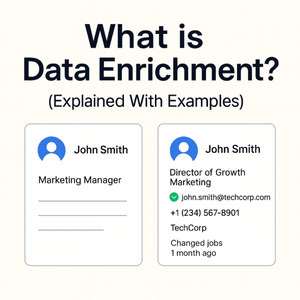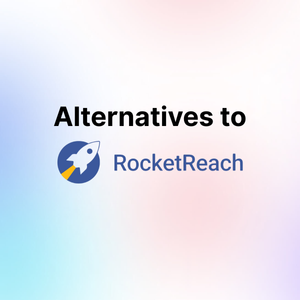Cold outreach is still one of the most effective ways to reach new prospects and win customers in 2025. When it is planned well, it opens doors to valuable conversations, builds relationships, and generates consistent leads. Forget spray and pray emails and outdated scripts. This is about targeted messages, tailored to the right people, at the right time.
In this guide, you will learn what cold outreach is, why it works, and how to make it a reliable lead generation channel. We will cover proven cold email templates, best practices, and the tools that make campaigns faster, more scalable, and more effective.
Table of Content:
- What is Cold Outreach and Why It Works
- The Business Case for Cold Outreach in 2024
- How to Write Effective Cold Emails That Get Responses
- Cold Outreach Best Practices and Common Mistakes to Avoid
- Top Cold Outreach Tools and Automation Platforms
- How to Improve Response Rates and Generate More Leads
- Advanced Cold Outreach Strategies for Multichannel Campaigns
What is Cold Outreach and Why It's Essential for Business Growth
Cold outreach is a proactive outbound marketing strategy where you reach out to potential customers who have no prior relationship with your business. It involves contacting people who have not yet shown interest in your product or service, making it a key way to pitch to new audiences and expand your customer base.
Key Components of Successful Cold Outreach:
- Prospecting and Research: Identifying and researching your target audience without prior connections
- Personalized messaging: Writing emails and crafting compelling emails tailored to each prospect
- Multichannel approach: Using email automation, LinkedIn, phone calls, and other platforms
- Automation tools: Using cold outreach tools to scale outreach efforts efficiently
- Follow-up sequences: Building relationships through consistent communication and engaging prospects
A major challenge in sales leadership today is outdated thinking about outreach. Many leaders stick to old beliefs even though they have never tested modern cold email strategies or learned from early mistakes. There is often a false choice between cold emails and cold calls, and very few teams excel at both.
Why Cold Outreach Outperforms Traditional Methods:
Cold calling is difficult these days. Decision-makers are barely accessible by phone. Plus, remote work arrangements and mobile devices complicate it even more. Add in low response rates, a big time sink and the costs of dialing, and we have a clear winner.
But despite all that, many traditional sales directors still swear off cold email outreach - whether it's because of their first failed attempts or thinking that cold emails are too pushy, could risk violating data privacy laws (they don't), could negatively impact the company's image or simply aren't effective.
The reality is that modern cold outreach, when done correctly with proper personalization and cold outreach tools for seamless automation, can be one of the most effective lead generation strategies available to businesses today. By focusing on best practices like avoiding technical jargon, keeping messages short yet powerful, and researching your target audience thoroughly, you can establish meaningful connections with potential customers.
The Business Case for Cold Outreach and Lead Generation
These are our top six reasons why cold outreach doesn't deserve the reputation it gets in some circles:
1. Cold Outreach is Proven to Generate Quality Leads
Cold email has stood the test of time as a fundamental B2B sales channel. For decades, it has consistently proven its value in reaching and engaging potential customers without prior relationships.
Today, where nearly 350 billion emails are sent globally every day, email is an even more ubiquitous and indispensable tool for communication. It makes sense then that studies reveal that a significant 80% of buyers prefer to be contacted via email.
That's why 44% of CMOs vouch for email marketing. Additionally, they're willing to put 8% of their marketing budget into these initiatives.
Cold Outreach Statistics That Matter:
- 91% of prospects prefer email over other communication channels
- Companies using cold outreach see 45% higher lead generation rates
- Personalized cold emails have 29% higher open rates than generic messages
- Automated cold outreach can reduce prospecting time by 60%
With its track record, cold outreach is an essential part of B2B lead generation. And despite new digital channels, it remains a cornerstone method for initiating connections, generating leads and closing deals.
2. Effective Cold Emails Get Measurable Results
The beauty of cold outreach is that it's trackable and measurable. You can see how many prospects opened the email, replied and turned into deals. This means we can look at what works and what doesn't.
For example, we know that using cold email templates with personalization can significantly affect the success of our outreach campaigns. Using a person's name or company in the subject line can boost open rates to 43.41%. We can increase our chances in other ways, too. Questions in subject lines can increase open rates by 11% because you piqued the lead's curiosity.
What about actual replies and moving leads down the funnel? Studies show email sequences that include 4-7 messages can have 3x response rates compared to shorter ones.
What about actual replies and moving leads down the funnel? Studies show cold email sequences that include 4-7 messages can have 3x response rates compared to shorter ones.
At Findymail, we're averaging around an 8% reply rate and close a deal every 300 cold outreach emails. Of course, we specialize in B2B contact information, so we have a competitive advantage, but as we say – iteration to perfection.
Key Metrics for Cold Outreach Success:
- Open rates: 20-25% (industry average)
- Response rates: 5-10% (well-executed campaigns)
- Conversion rates: 1-3% (from cold email to customer)
- ROI: $36 return for every $1 spent on email marketing
3. Cold Outreach Tools Offer High ROI and Scalability
Another plus side of cold outreach strategies is their ROI. For every dollar spent on email marketing, companies can see returns as high as $36.
Of course, frequency plays a role in getting the best results. We'd say somewhere between 9-16 emails per month is optimal. That way you keep regular contact with prospects without overwhelming them.
Cold outreach wins when compared to other marketing channels like social media advertising, too. It's about 40x more effective at acquiring customers than organic or paid Facebook or Twitter.
ROI Benefits of Cold Outreach Automation:
- Lower cost per lead compared to paid advertising
- Scalable prospecting without proportional cost increases
- Higher conversion rates than cold calling
- Measurable results with detailed analytics
- Ability to A/B test and optimize campaigns continuously
If you want to maximize the ROI you get from every initiative, cold outreach is the best approach for sustainable lead generation
4. Cold Outreach Best Practices Allow for Laser-Focused Targeting
Precision targeting increases the relevance of each message and the likelihood of engagement. With detailed customer profiles, you create a holistic view of each lead's specific needs and interests.
From there, you can segment your prospecting lists based on various criteria – such as demographic details, past purchasing behavior or engagement levels – so that each prospect receives the most personally relevant content.
The benefit here is that segmented cold email campaigns have been shown to increase revenue by as much as 760%.
Advanced Targeting Strategies for Cold Outreach:
- Industry-specific messaging and pain points
- Role-based personalization for decision makers
- Company size and revenue-based segmentation
- Geographic and timezone considerations
- Technology stack and tool usage targeting
The real secret of effective cold outreach is its iterative A/B testing process to refine your strategy. You experiment with all parts of your emails, from subject lines to the call to action, to find what delivers the most revenue.
The A/B testing approach can increase your email engagement by up to 37%.
In essence, cold outreach offers a unique opportunity to target potential customers more accurately and discover how to truly connect with them, giving it a clear advantage over other marketing channels.
5. Multichannel Cold Outreach Increases Brand Awareness and Lead Generation
One attribute that helps cold outreach stay relevant is that you can reach a broad audience directly and efficiently. It's a direct line of communication to your potential customers.
The biggest pro is the ability to scale without significantly increasing costs. With traditional advertising, you'd need a substantial budget for ad space on LinkedIn, Google Ads or conference sponsorships.
Another factor to consider is that cold outreach emails serve as the initial touchpoint that can start a dialogue between your brand and potential customers. This interaction can be nurtured over time through well-planned follow-up emails, gradually building a relationship that leads to a sale.
Each email in the sequence can offer additional value, further establishing the brand's credibility and trustworthiness.
Multichannel Cold Outreach Benefits:
- Email sequences for consistent touchpoints
- LinkedIn outreach for professional networking
- Phone follow-ups for high-priority prospects
- Social media engagement to build familiarity
- Coordinated messaging across all channels
By coordinating cold outreach campaigns with social media, content marketing or event marketing, you can create a cohesive strategy that reinforces the brand message across multiple platforms and offers a practical entry point for every qualified lead to start talking to you on their terms.
6. Strategic Cold Outreach Fights Ad Fatigue
Ad fatigue is never pleasant, but nowhere is it as dangerous as in B2B sales, where cycles are typically longer and involve multiple touchpoints before a prospect converts into a customer.
With the average American seeing from four to ten thousand ads every day and 91% of them considering them intrusive, you need a better icebreaker.
On the other hand, we all live in our inboxes. They're the first and last things your prospects review every day. Unlike an ad, your cold outreach message reaches them directly and there is no "diffusion." The message is meant for them and, if written well, resonates enough to initiate contact.
Since you can hyper-personalize your cold outreach emails using automation tools, prospects are less likely to perceive them as generic advertising. Instead, they'll understand how you can bring value to their table.
How Cold Outreach Overcomes Ad Fatigue:
- Direct, personal communication vs. mass advertising
- Targeted messaging based on specific needs
- Value-driven content rather than promotional copy
- Ability to start genuine conversations
- Less competition in the inbox compared to ad platforms

How to Write Effective Cold Emails That Generate Responses and Avoid Common Pitfalls
Now that we've covered why cold outreach is still relevant, let's cover how to do it properly and maximize its potential through effective strategies.
Writing Emails That Engage Prospects: Template Structure and Best Practices
Learning how to write effective cold emails is crucial for successful cold outreach campaigns. The key is creating personalized emails that are short yet powerful, with engaging subject lines that boost open rates and clear calls to action.
Essential Cold Email Template Components:
1. Engaging Subject Lines That Get Opened:
- Keep it short (6-8 words maximum) to avoid technical jargon
- Personalize with prospect's name or company
- Create curiosity without being misleading
- A/B test different approaches for targeted messaging
2. Personalized Email Opening:
- Reference specific research about their company
- Avoid generic expressions and assumptions
- Show you understand their industry challenges
- Keep it conversational, not pushy communication
3. Short Yet Powerful Value Proposition:
- Focus on the prospect, not your product
- Address specific pain points you've researched
- Keep messaging concise to avoid overwhelming emails
- Demonstrate clear understanding of their needs
4. Call to Action That Makes It Easy to Respond:
- Suggest a simple next step (15-minute call, email response)
- Give multiple options to increase response rate
- Make it about their schedule and preferences
- Avoid pushy or demanding language
Understanding Cold Outreach Best Practices and Targeting for Maximum Impact
Targeting is the foundation of any successful cold outreach campaign. It involves identifying and reaching out to prospects that align with your ICP or ideal customer profile through effective strategies that help you establish connections with the right audience.
Research Target Audience - Best Practices:
Data is your best tool for defining your ICP. Start by looking at your existing customers to spot patterns in the types of companies and people who convert. Identify the characteristics and behaviors linked to your best results.
Key targeting criteria for cold outreach:
- Firmographic details: Industry, company size, location, and revenue range.
- Purchasing behavior: Buying frequency, deal size, and decision-making timelines.
- Interaction history: Past engagements with your brand, such as webinar attendance or content downloads.
- Decision-making authority: Role, seniority level, and influence on purchasing decisions.
- Technology stack: The tools and platforms they already use that might connect with your offer.
- Pain points and challenges: Specific problems your solution can address.
- Growth indicators: Hiring trends, funding rounds, or expansion plans.
- Communication preferences: Channels and formats they respond to most.
Based on the patterns you observe, your next step will be segmentation.
Break your potential market into groups of prospects with similar profiles that match your ICP. Leveraging cold outreach tools like your CRM software, email marketing platforms and data enrichment systems will help here.
Top Tools for Cold Outreach Success:
- Email Marketing Tools: Platforms for creating and sending personalized emails
- Prospecting Tools: Software for finding and researching potential customers
- Automation Tools: Systems for scaling outreach efforts efficiently
- Cold Email Platforms: Specialized software for cold emailing campaigns
- Outreach Software: Comprehensive solutions for multichannel campaigns
For example, if you use Findymail's B2B contact information and CRM Datacare solutions, you will get the most accurate email addresses for your cold outreach campaigns directly into your CRM.
And with Datacare's deduplication and automatic updates, you'll fill the information gaps and ensure your team can reach out with confidence.
Prospecting Tools for Better Targeting:
- Contact databases with verified email addresses
- Social media insights for personalization
- Company research tools for context
- Intent data to identify buying signals
- CRM integration for seamless workflow
How to Automate Cold Outreach: Email Warmup and Scaling Strategies
Learning how to automate prospecting is essential for scaling your cold outreach efforts without losing personalization. Email automation and multichannel platforms enable seamless automation while maintaining the personal touch that drives successful campaigns.
Email Warmup and Deliverability for Automated Outreach:
Email deliverability is crucial for successful cold outreach campaigns. It both looks at your sender reputation (your legitimacy as a sender, based on your domain setup and emailing behavior) and the accuracy of the email addresses you send mail to.
Email Warmup Best Practices:
- Gradually increase sending volume over 2-4 weeks
- Start with small batches (10-20 emails per day)
- Use email warmup tools for automated reputation building
- Monitor deliverability metrics closely during ramp-up
- Maintain consistent sending patterns to establish trust
Understanding Sender Reputation in Cold Outreach
Sender reputation in cold outreach reflects how email service providers (ESPs) and recipients perceive the sender based on past email-sending behavior. It encompasses factors such as email engagement rates, spam complaint rates and overall email deliverability.

For example, if a salesperson consistently delivers personalized and valuable content that resonates with recipients, their sender reputation is likely to be positive. As a result, their cold emails are more likely to reach the recipients' inboxes.
On the other hand, if they send generic emails that result in high spam complaint rates or low engagement, their sender reputation may suffer, leading to decreased deliverability.
Email Warmup and Deliverability Best Practices:
- Gradual sending volume increases
- High-quality email content that engages recipients
- Proper SPF, DKIM, and DMARC authentication
- Regular list cleaning and bounce management
- Monitoring sender reputation scores
How Email Accuracy Factors into Cold Outreach Success
Firstly, sending emails to incorrect addresses results in high bounce rates (emails not reaching inboxes). Use our email verification solution to avoid low-quality practices. Your domain might be blacklisted or, at the very least, your emails will be relegated to the Promotions folders.
Secondly, accurate email addresses mean that your emails will reach the right recipients. Tools like Findymail offer actionable, rich email data.
Finally, if you have a robust CRM lead enrichment strategy, an accurate email address is the foundation for getting the rest of your data, including firmographic, technographic and intent data, which you can use to tailor your cold emails according to your ICP’s current challenges and goals.
Of course, cold outreach goes beyond the tools and tech you use. There are things behind the scenes you need to know like:
- Sender Policy Framework (SPF)
- Domain-Based Message Authentication Reporting and Conformance (DMARC)
- DomainKeys Identified Mail (DKIM)

Domain Strategy for Cold Outreach: Another issue is using your primary domain for cold emailing campaigns. It can pose risks such as damaging your domain's reputation and deliverability if marked as spam. To mitigate these risks, use a dedicated subdomain or a completely separate domain for cold outreach. This approach keeps your main communication domain from being blacklisted.
Tools like Woodpecker and other cold outreach platforms help automate this process and maintain high deliverability rates with automatic warmup and more.
Crafting Compelling Cold Email Templates with Personalization
While we've touched on the impact of personalization above, it deserves more time. It's key in differentiating your emails from the countless others flooding your prospects' inboxes.
We showed how personalized subject lines improve open rates but personalization within the cold email content can increase response rates by as much as 140% and click-through rates by 81.5%.
But how do you create compelling, personalized content for someone you've never met?
Advanced Personalization Strategies for Cold Outreach:
- Use of Data and Insights: Get as much relevant data about your prospects as possible. This can include their industry, role, recent business achievements or challenges they are facing.
- Segmentation: Segment your email list to tailor your messages more precisely. Again, this requires a keen understanding of your ICP and what resonates with them.
- Dynamic Content: Use dynamic content in your emails that adjusts according to the data you have on each prospect. This could include different images, body text or offers based on the recipient's past interactions.
- A/B Testing: Always test and refine your approach. Test different cold email templates within the same segments. The goal is to optimize each part of your cold outreach email so nothing is wasted.
Cold Email Template Components:
- Subject Line: Clear, curiosity-driven, personalized
- Opening Line: Reference specific details about their company
- Value Proposition: Focus on their pain points and needs
- Social Proof: Include relevant case studies or testimonials
- Call to Action: Simple, specific, and easy to respond to
- Signature: Professional with multiple contact options
Cold Outreach Automation and Scaling Strategies
Modern cold outreach relies heavily on automation tools to scale efforts while maintaining personalization. The key is finding the right balance between efficiency and human touch.
Essential Cold Outreach Tools and Platforms:
- Email Automation: Tools like Outreach, SalesLoft, and Woodpecker
- Prospecting Platforms: ZoomInfo, Apollo, and Sales Navigator
- Email Verification: Findymail, NeverBounce, and ZeroBounce
- CRM Integration: HubSpot, Salesforce, and Pipedrive
- Analytics Platforms: Track opens, clicks, and responses
Automation Best Practices:
- Set up trigger-based sequences based on prospect behavior
- Use AI-powered personalization at scale
- Implement multichannel touchpoints (email, LinkedIn, phone)
- Create separate sequences for different buyer personas
- Monitor and adjust based on performance metrics
Common Mistakes to Avoid in Cold Outreach Campaigns
Even with the best intentions, many cold outreach campaigns fail due to common mistakes that hurt response rates and damage sender reputation. Understanding these pitfalls is crucial for building successful campaigns.
Top Cold Outreach Mistakes and How to Avoid Them:
1. Lack of Personalization and Generic Expressions: Sending mass emails with generic expressions instead of personalized messages kills response rates. Avoid assumptions about prospects' needs and invest time in research to create targeted messaging.
2. Overwhelming Emails and Technical Jargon: Using complicated language or overwhelming emails with too much information confuses prospects. Keep it short, avoid technical jargon, and focus on one clear message per email.
3. Not Focusing on Prospect and Pushy Communication: Making the email about your product instead of not focusing on prospect needs creates pushy communication that prospects ignore. Always lead with their challenges and interests.
4. Poor Research Target Audience Preparation: Failing to research target audience properly leads to irrelevant outreach. Spend time understanding their industry, role, and current challenges before reaching out.
5. Lack of Personalization in Follow-up Sequences: Using the same generic follow-up for everyone shows lack of personalization. Tailor each touch point based on their specific situation and previous interactions.
6. Ignoring Email Automation Best Practices: Poor email automation setup without proper email warmup damages deliverability. Implement seamless automation that maintains human touch and follows best practices.
How to Avoid These Mistakes and Build Effective Strategies:
- Invest time in prospect research and personalize messages authentically
- Focus on value and relationship-building over immediate pitching your product
- Implement proper technical setup and email warmup processes
- Test and optimize engaging subject lines continuously
- Clearly articulate how you solve their specific problems
- Space out touchpoints appropriately using multichannel platforms
- Create systematic follow-up sequences that add value each time
- Use analytics to guide optimization efforts and increase response rate
- Avoid assumptions by doing thorough research on each prospect
- Keep messaging concise and avoid overwhelming emails or pushy communication
How to Generate Leads Through Cold Outreach: Building Relationships and Successful Campaigns
Lead generation through cold emailing requires a strategic approach focused on building relationships rather than immediate sales. The goal is to generate leads by engaging prospects authentically and providing genuine value.
Cold Outreach Lead Generation Strategy:
1. Identify High-Value Prospects for Lead Generation:
- Use prospecting tools to find ideal customers
- Focus on companies showing buying signals
- Target decision-makers with relevant pain points
- Prioritize accounts with higher conversion potential
2. Craft Compelling Cold Emails That Generate Leads:
- Start conversations, don't just pitch
- Share relevant insights or industry trends
- Offer valuable resources (case studies, tools, insights)
- Position yourself as a helpful resource, not a vendor
3. Building Relationships Through Consistent Value:
- Provide useful information in each touchpoint
- Share relevant content that helps their business
- Engage with their social media posts and content
- Offer genuine help before asking for anything
4. Successful Campaigns Focus on Long-term Relationships:
- Plan multiple touchpoints over weeks/months
- Vary your approach across different channels
- Track engagement and adapt messaging accordingly
- Focus on building trust and credibility over time
Advanced Cold Outreach Strategies for Maximum Lead Generation
Once you've mastered the basics of cold outreach, these advanced strategies can significantly improve your results and help you scale outreach efforts more effectively:
Multichannel Cold Outreach Approach Using Automation Tools
The most successful cold outreach campaigns use multichannel platforms to reach prospects where they're most active and responsive. This approach combines email automation with other channels for seamless automation across touchpoints.
Multichannel Strategy Components for Effective Outreach:
- Email: Primary channel for detailed communication and personalized emails
- LinkedIn: Professional networking and social selling to engage prospects
- Phone Calls: High-touch follow-up for qualified prospects and building relationships
- Social Media: Engage with content and build familiarity before outbound marketing
- Direct Mail: Stand out with physical touchpoints in your targeted messaging
Intent-Based Cold Outreach
Use intent data and buying signals to identify prospects who are actively researching solutions like yours.
Intent Signals to Monitor:
- Website visits and content downloads
- Job postings for relevant roles
- Technology adoptions or changes
- Company growth announcements
- Industry event participation
Account-Based Cold Outreach
For high-value target accounts, implement coordinated outreach across multiple stakeholders within the organization.
ABM Cold Outreach Strategy:
- Map decision-making units within target accounts
- Create account-specific messaging and content
- Coordinate outreach timing across multiple contacts
- Personalize based on company-wide initiatives
- Track engagement across all account stakeholders
How to Improve Response Rates and Boost Open Rates in Cold Outreach
To increase response rate and create successful campaigns, focus on strategies that help you engage prospects more effectively through targeted messaging and personalized approaches.
Proven Strategies to Improve Cold Outreach Performance:
Personalize Messages for Higher Engagement
The key to effective outreach that gets responses is deep personalization beyond just using their name:
- Reference specific company news, achievements, or challenges
- Mention mutual connections or shared experiences
- Comment on their recent social media posts or content
- Relate to their industry trends or seasonal challenges
- Show genuine interest in their business growth
Optimize Timing and Frequency to Boost Open Rates
Strategic timing can significantly increase response rate:
- Send emails Tuesday-Thursday, 9-11 AM or 1-3 PM in their timezone
- Avoid Mondays (busy catch-up) and Fridays (weekend prep)
- Space follow-ups 3-7 days apart for optimal engagement
- Test different sending times for your specific audience
- Consider their industry patterns (B2B vs B2C timing differences)
Create Targeted Messaging That Resonates
Successful campaigns focus on relevance and value:
- Segment prospects by industry, role, company size
- Tailor pain points and solutions to each segment
- Use language and terminology familiar to their industry
- Reference competitors or industry benchmarks appropriately
- Align messaging with their business goals and priorities
Key Cold Outreach Metrics:
- Email Deliverability Rate: Percentage of emails successfully delivered
- Open Rate: Percentage of delivered emails that are opened
- Response Rate: Percentage of emails that receive replies
- Meeting Booking Rate: Percentage of responses that convert to meetings
- Pipeline Generated: Total value of opportunities created
- Cost Per Lead: Total campaign cost divided by leads generated
- Customer Acquisition Cost: Cost to acquire customers through cold outreach
Optimization Strategies:
- A/B test subject lines, email copy, and send times
- Segment audiences for more targeted messaging
- Refine ideal customer profiles based on response data
- Adjust follow-up sequences based on engagement patterns
- Integrate feedback from sales team on lead quality
Navigating Privacy Laws and Regulations for Cold Outreach
The three key laws related to cold outreach include:
- The General Data Protection Regulation (GDPR)
- The California Consumer Privacy Act (CCPA)
- The Controlling the Assault of Non-Solicited Pornography And Marketing Act (CAN-SPAM)
What Does GDPR Say about Cold Outreach?
Despite the misinformation, GDPR does not forbid cold outreach. Instead, the best practices for implementing it state that you should have a legitimate interest in contacting the prospect, i.e., you should have grounds to believe they would benefit from your offer.
Assuming you will do in-depth research and tailor the offer to your prospects, you will be well within your rights to contact them through cold outreach. Of course, always allow the recipients to unsubscribe and offer a way for them to request data deletion.
What Does CCPA Say about Cold Outreach?
The CCPA, while specific to California, shares many of the same hallmarks as GDPR with a focus on consumer rights to privacy and control over their personal data. Under the CCPA, if you send cold outreach emails to California residents, you have to clarify how the data has been collected and how it will be used.
Similarly to GDPR, Californian residents have to be able to opt out of the messaging and request for their data to be deleted. However, you can still contact them through cold outreach, presuming you have also met the requirements for GDPR.
CAN-SPAM and Cold Outreach
CAN-SPAM regulates what your cold outreach emails should include, but it doesn't forbid them. For example, CAN-SPAM states you should use accurate From, To and Reply-To headers, include an opt-out mechanism, state your physical address and never use deceptive subject lines.
And there are many other laws around the world, but the idea is the same – be careful with how you're using data. Compliance starts with understanding the specific requirements of each regulation.
Level Up Your Lead Generation with Cold Outreach and Advanced Tools
Cold outreach doesn't operate in isolation. It complements and amplifies existing marketing and sales strategies.
As we've explored in this article, it's not only an effective method for direct communication and lead generation, but it also significantly enhances ROI and brand awareness.
However, successful cold outreach campaigns rely on the quality of your data and the effectiveness of your automation tools. Findymail has recently introduced Datacare, a feature designed to ensure your CRM and contact information data is always clean, updated and compliant with the latest data protection regulations.
Datacare automatically enriches and cleans your CRM data. It keeps your email lists free of duplicates and outdated information, so you can maintain low bounce rates and improve the overall health of your lead generation pipeline.
With Datacare, you can significantly reduce the time spent on data management and spend more focused on strategic engagement and closing deals. Ready to see how Datacare can help your cold outreach approach? Schedule a 15 min call today to learn more.
Frequently Asked Questions (FAQ)
What is cold outreach and how does it work?
Cold outreach is a proactive marketing strategy where you initiate contact with potential customers who have no prior relationship with your business. It typically involves sending personalized emails, LinkedIn messages, or making phone calls to prospects who fit your ideal customer profile. The goal is to start conversations that can lead to business relationships and sales opportunities.
What are the best practices for cold outreach campaigns?
Effective cold outreach best practices include thorough prospect research, personalized messaging, clear value propositions, professional email setup, gradual sending volume increases, and systematic follow-up sequences. It's essential to focus on the prospect's needs rather than just pitching your product, and to maintain compliance with privacy regulations like GDPR and CAN-SPAM.
How do I write effective cold emails that get responses?
To write effective cold emails, start with compelling subject lines that create curiosity, personalize the opening based on prospect research, clearly articulate how you can solve their specific problems, include relevant social proof, and end with a simple call-to-action. Keep emails concise, avoid jargon, and focus on providing value rather than making immediate sales pitches.
What tools are best for cold outreach automation?
Top cold outreach tools include email automation platforms like Outreach and SalesLoft, prospecting tools like ZoomInfo and Apollo, email verification services like Findymail, and CRM systems for lead management. The best tool combination depends on your specific needs, budget, and target audience size.
How can I improve my cold outreach response rates?
To boost response rates, focus on hyper-personalization using prospect research, craft compelling subject lines, send emails at optimal times, implement strategic follow-up sequences, provide clear value propositions, and continuously A/B test different elements of your campaigns. Quality targeting and relevant messaging are more important than sending volume.
What are common mistakes to avoid in cold outreach?
Common cold outreach mistakes include sending generic mass emails, being too pushy or salesy, neglecting proper technical setup, having weak subject lines, failing to follow up consistently, not tracking performance metrics, and ignoring legal compliance requirements. Avoid these by focusing on personalization, value creation, and systematic optimization.
How many follow-up emails should I send in a cold outreach sequence?
Most effective cold outreach sequences include 4-7 follow-up emails spaced 3-7 days apart. However, the exact number depends on your industry, target audience, and campaign objectives. The key is to provide new value or perspective in each follow-up rather than simply repeating the same message.
Is cold outreach legal and compliant with privacy laws?
Yes, cold outreach is legal when done correctly and in compliance with regulations like GDPR, CCPA, and CAN-SPAM. You need legitimate business interest, accurate sender information, clear opt-out mechanisms, and proper data handling practices. Always research specific requirements for your target regions and industries.
How do I measure the success of my cold outreach campaigns?
Key metrics for measuring cold outreach success include email deliverability rates, open rates, response rates, meeting booking rates, pipeline generated, and customer acquisition cost. Use analytics tools to track these metrics and optimize your campaigns based on performance data to continuously improve results.
What's the ROI of cold outreach compared to other marketing channels?
Cold outreach typically offers excellent ROI, with email marketing generating $36 return for every $1 spent on average. It's often more cost-effective than paid advertising, has higher conversion rates than cold calling, and provides better targeting capabilities than mass marketing approaches. The exact ROI depends on execution quality and industry factors.







